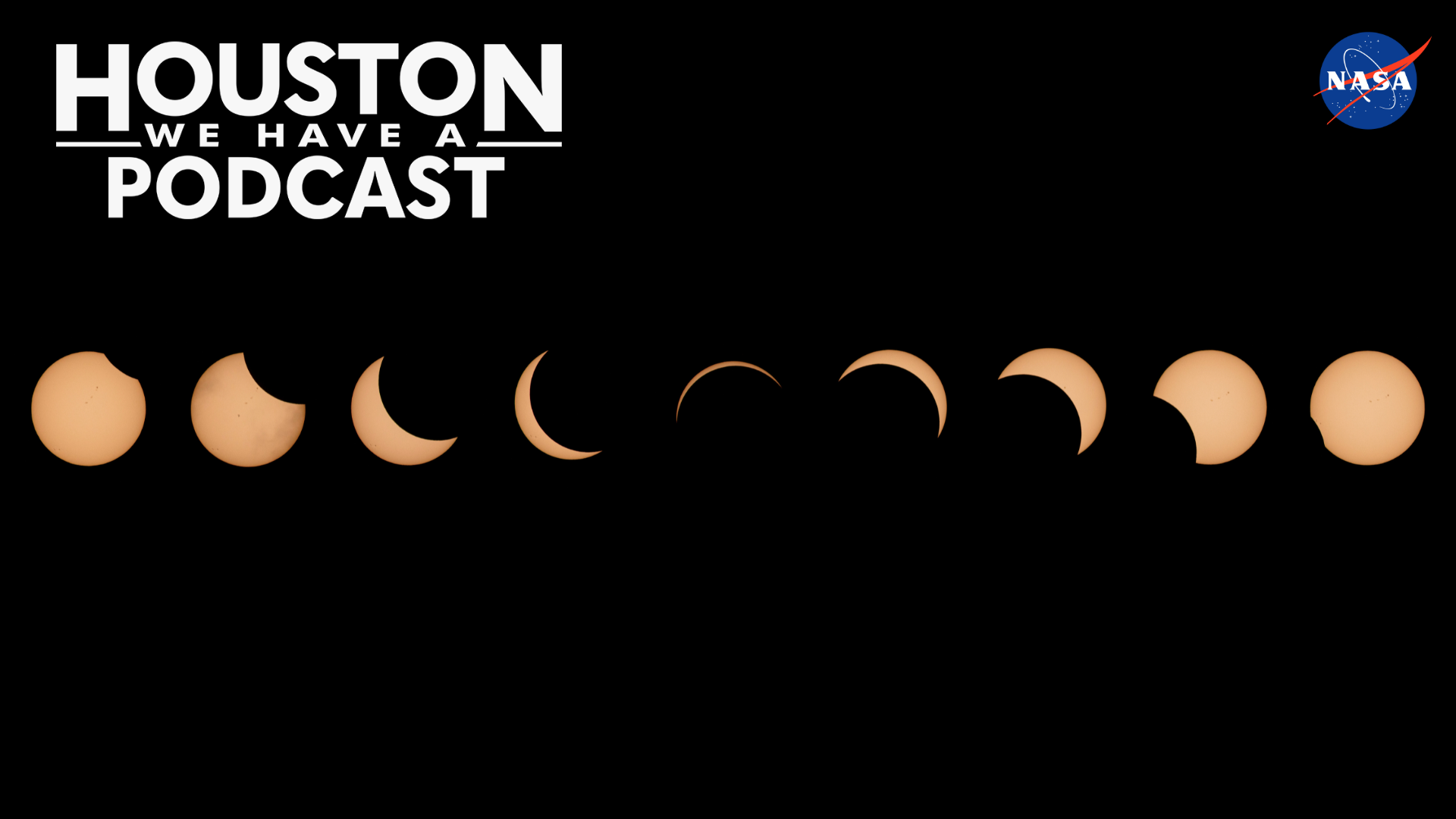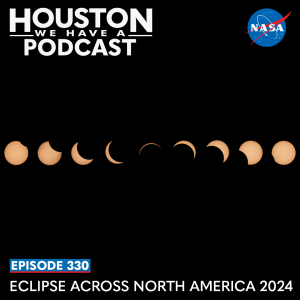
From Earth orbit to the Moon and Mars, explore the world of human spaceflight with NASA each week on the official podcast of the Johnson Space Center in Houston, Texas. Listen to in-depth conversations with the astronauts, scientists and engineers who make it possible.
On episode 330, a NASA flight controller discusses all you need to know about the total solar eclipse happening on April 8, how to best witness it, and the safety precautions that come with it. This episode was recorded on March 1, 2024.

Transcript
Gary Jordan: Houston, we have a podcast! Welcome to the official podcast of the NASA Johnson Space Center, Episode 330, “Eclipse Across North America 2024.” I’m Gary Jordan, and I’ll be introducing a new host today. On this podcast, we bring in the experts, scientists, engineers, and astronauts, all to let you know what’s going on in the world of human spaceflight and more. And for this episode, I’m very excited to welcome a new voice of the podcast, Kenna Pell. Kenna, welcome.
Kenna Pell: Hey, Gary, thank you so much for having me. More than what? 300 episodes. It’s quite an honor to be here and to learn from you.
Gary Jordan: Yeah, I mean, you auditioned and it was super clear that you would be an awesome voice for this. But you were not always at JSC, not always around here, but it was great to have you around here. Originally, your last job you had was over at the Kennedy Space Center.
Kenna Pell: No, I was not always at JSC and I absolutely love it here. I love Houston. But I also love where I came from, like you said, at KSC. They’re so different, but so also the same in many ways as the NASA family, right? So transitioning from Kennedy Space Center over here to Johnson has been so much fun and I’m really happy to be here.
Gary Jordan: So, in terms of your role, you work very closely with the International Space Station program, is that right?
Kenna Pell: I do. And I love my role. I work strategic and internal comms for the program, which is based here at Johnson Space Center. And I absolutely love it. Everyone knows that I love ISS.
Gary Jordan: Yeah. And you’re going to be doing some of the episodes coming up, have to do with ISS, so it’ll be great to have you as a recurring voice on this podcast.
Kenna Pell: Well, thanks, Gary. It is really cool to learn from you.
Gary Jordan: Well, you’re going to take it away for the great North American eclipse. Are you ready?
Host: Let’s do it.
Gary Jordan: Alright. Take it away.
Host (Kenna Pell): On April 8, 2024, a total solar eclipse will cross North America passing over Mexico, the United States, and Canada. This kind of eclipse is an awe-inspiring event that drastically changes how we see the two biggest objects in our sky: the Sun and Moon. While the path of totality over the United States begins here in Texas and crosses all the way up to Maine, the great news is that during this eclipse, all of the contiguous U.S. will be able to see at least a partial eclipse. We have Matt Wilkinson, a flight controller here at Johnson Space Center, joining us today to talk all things eclipse.
Now, Matt’s primary role is orbital mechanics on various consoles supporting ISS and Artemis in mission control. But we will get to his connection to eclipses at the beginning of the conversation. And here’s everything you need to know about this phenomenon, how to best witness it, and the safety precautions that come with it. And find out why you don’t want to miss out on this rare celestial event, because the next time a total solar eclipse is visible from the contiguous U.S., well, let’s just say it’ll be a few decades. Let’s get started.
[Music]
Host: Matt, thanks for joining us today.
Matt Wilkinson: Yeah, happy to be here.
Host: So one thing I love about working for the agency is there is a multitude of different jobs that everyone across, you know, the center or just the agency as a whole has. And I’m wondering from you, what do you do for NASA? But could you give us the high-level family and friends description?
Matt Wilkinson: Sure thing. So I’m a flight controller. I work in mission control and my area of focus is oral mechanics and rendezvous.
Host: And now what is the more descriptive? What do you do on the day-to-day?
Matt Wilkinson: So we work with various partners, so SpaceX, Boeing, JAXA (Japan Aerospace Exploration Agency), and others to make sure that their vehicles get to the ISS safely for the ISS program and that we can safely have two vehicles meet up in lunar orbit for the Artemis missions.
Host: So you work both ISS and Artemis?
Matt Wilkinson: I do, yeah.
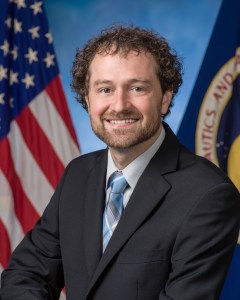
Host: That’s really exciting to see both of those. And what was your path to NASA?
Matt Wilkinson: So when I was a kid, my family visited Johnson Space Center on a family vacation. And I was just hooked from the moment we stepped on site. Getting to see the Saturn V out at Rocket Park and taking the tour of mission control on the tram was really, really cool. So from that point, you know, I devoured everything I could find, movies, books, television. In high school I did high school aerospace scholars and then I did aerospace engineering in college, did some internships and then got a job here.
Host: So orbital mechanics, working in mission control. You work ISS and Artemis. How does your day-to-day job apply to your understanding of solar eclipses?
Matt Wilkinson: So I’m not a planetary scientist. My primary concern is where the Moon is in terms of interference with our sensors. So my job involves a lot of orbital mechanics and we also use a lot of vision-based sensors to track where the target vehicle that we’re trying to get the chaser vehicle to meet. One of those sensors is called a star tracker. And the way it works is it looks out from the vehicle and it sees the path of all the stars as it’s flying and it has a known map of the stars. And so it can go, okay, I look out, I see this pattern of stars, these constellations and things, and they match this map that I was given. So I know that I’m here. It’s very similar to what sailors would do during the age of exploration.
But the problem is the Moon is super bright and it can fool the star trackers or block out some of the light. So when we’re planning our missions, we have to make sure that as the vehicle is flying, that it’s not going to be fooled by the Moon passing through its field of view. We’ve seen it on console where the Moon can trick the sensors into thinking it’s the ISS cause it’s looking for a big shiny thing.
We’ve actually seen, you know, it’s tracking this thing and then we look in our graphics and you see the Moon moving and you’re like, “Nope. It’s tracking the Moon.” So that’s primarily where my interest in, you know, lunar orbits comes from, is making sure that we plan our mission so that we don’t have to worry about lunar interference. And then with the Artemis stuff, we really do have to make sure that we have a lit landing site.
Host: Thanks Matt. So before we dive into some general total solar eclipse questions, I want to say for the ease of our listeners and for their sanity, so they don’t keep hearing me stumble over this, can we say eclipse as sort of synonymous to just saying total solar eclipse in this sense?
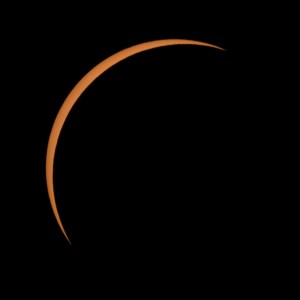
Matt Wilkinson: Absolutely. Yeah.
Host: Okay. So everyone, all our listeners, we’re going to say eclipse so you don’t have to hear us, or not you, Matt, at least stumble over saying it a couple times here. So first and foremost, where were you for the last solar eclipse over America in 2017?
Matt Wilkinson: So that was a workday. So I was actually here on site and when it came time for the eclipse, several of us went outside of the mission control building and watched the eclipse there. Several of the folks had special telescopes with protective lenses and so we were able to watch it that way. And then we also were able to see some really cool shadowing of indirect viewing by watching the light through the leaves on the trees as they cast shadows on the sidewalk.
Host: Where are you going to be for this year’s eclipse?
Matt Wilkinson: So several of us are planning a trip out to the hill country to go watch it. We do have a mission coming up later in April, so I may not be able to go, but I’m really hoping to get out for the totality to the hill country.
Host: And so for our listeners that might not be from Texas, what city is the hill country by? More towards San Antonio, maybe?
Matt Wilkinson: Yeah, it’s a little west of Austin, San Antonio.
Host: Okay, I know we have a viewing host site at Kerrville. Is that near Kerrville?
Matt Wilkinson: Yes.
Host: Okay. Let’s dive into everything you need to know about the upcoming solar eclipse. Let’s start with the basics. Can you tell us what a total solar eclipse is?
Matt Wilkinson: Sure thing. So eclipses, in general, are when the dance of the orbits of the Earth, the Sun and the Moon all line up. And so the Earth is going around the Sun and the Moon is going around the Earth, but the Moon is actually tilted as it goes around the Earth about 23 degrees. So sometimes it’s above where the Earth and the Sun are, and sometimes it’s below. An eclipse is when the Moon is going from either below to above or from above to below as it’s passing through the line between the Sun and the Earth. So you get all three bodies lined up together and you have the Moon blocking the light from the Sun as it lands on the Earth. A total solar eclipse is one of those special times when not only are the three lined up, but the Moon is at the right distance such that its size matches the apparent size of the Sun as seen from people on Earth.
Host: Got it. Now what about a partial eclipse?
Matt Wilkinson: So partial eclipse would be either when the Moon just skirts the edge of how we can see the Sun or during a total or annular solar eclipse. For those not directly in the line of totality, they would be seeing a partial solar eclipse.
Host: So I like how you described it, it’s a dance of orbits. And it’s really, for the total solar eclipse, about the Moon’s position, right? Now, while it seems like just yesterday, recent right? Where we had the last total solar eclipse over America, that was 2017. And before that it was 1991. These are quite rare when it comes to seeing here in North America or America. How rare really are they?
Matt Wilkinson: So total eclipses can happen pretty frequently, but in terms of eclipses over the same area, you may go decades or centuries between having total solar eclipses over the same area.
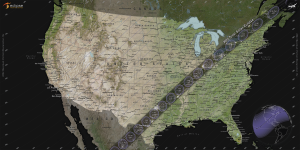
Host: Now when’s the next one?
Matt Wilkinson: So there will be a total solar eclipse over a small part of the U.S. in 2044. The next big one that covers most of the U.S. won’t be until 2045.
Host: Now do you know exactly where it’ll cross in 2044?
Matt Wilkinson: So it’ll cover the area just around maybe Montana and that part of the U.S., so kind of that very northwestern part.
Host: Which is interesting because the path of totality in 2017 and the one we have this year wasn’t over on the West Coast. So that’d be new for them, that’s exciting.
Matt Wilkinson: Yeah. And the one in 2045 will start in Northern California and do a big swath across most of the U.S. and end in central Florida. So a big chunk of the U.S. will get to see the path of totality.
Host: And that itself is new too. I know you can go to our different various, you know, resources to see the actual path and compare it to the one in 2017. And so that’s going to be a really cool one in just a different area. So now I want to talk about viewing the solar eclipse and some safety precautions that come with it. And how long for this eclipse does it last? Or how long can you see it or view it?
Matt Wilkinson: So the total period of the eclipse, in general, will be about three and a half hours. But any one area will only see it for about four minutes total.
Host: And so can you explain the difference in percentages? So there’s a path of totality and for example, here in Houston, I think we’re in the 94th percentile or 94%. What does that mean?
Matt Wilkinson: That’s describing just how much the Moon is actually blocking of the Sun’s photosphere, which is really the part of the Sun that we care about, cause that’s the part that can really damage your eyes. And so unless you’re in really that 100% area, you have to be very careful and take precautions when looking at the Sun.
Host: And speaking of being careful, how do you safely view the total solar eclipse?
Matt Wilkinson: So if you are in the path of totality and you are absolutely sure that you are there in that area, during those few minutes of totality, you can take off the solar eclipse glasses and look at the Sun. If you are not in that total path of blockage or you’re concerned about it, you should always use solar eclipse glasses to make sure that you protect your eyes from damage.
Host: That’s interesting that you say that. And when I was researching questions to ask, I had no idea actually that if you were in the path of totality, there’s a certain part where you can take off the glasses actually. And so you shouldn’t view through say your camera, on your phone. In that sense, in that timeframe, sure fine if you’re in the path of totality, but if you’re not, what are some other precautions?

Matt Wilkinson: Sure. So if you’re using solar eclipse glasses, which you should, make sure not to mix different devices with your glasses because telescopes, your phone, binoculars, things like that can change the to the intensity and magnification of the Sun and can change part of the wavelength that you see, which can then interfere with the protection provided by the eclipse glasses. If you’re going to use some kind of additional device, binoculars, telescope, phone, things like that, they sell dedicated protective lenses that you need to put on your device that would replicate the protection provided by those eclipse glasses. So make sure to not mix your devices, but use the appropriate lenses based on how you’re looking at the eclipse.
Host: Now, if you don’t have eclipse glasses or a handheld solar viewer, you can use other indirect viewing methods. What are those?
Matt Wilkinson: So there’s several, and they’re actually really cool with what they do. So, for example, what we did in 2017 is we watched the eclipse as the light was filtered through leaves. So as you look at the light through the leaves on, you know, a sidewalk or something, you’ll actually see thousands of little mini eclipses. And you can actually see the crescent of the Sun. You can get a similar effect with a colander or a strainer, take it out and hold it up above a sidewalk, a similar effect, or you can use what’s called a pinhole projector or pinhole camera. And it’s a similar theory where you cut a small hole in a piece of paper or a box and you have it shining on a piece of cardboard or another piece of paper or something, and the light will be redirected and you will see sort of the shadow of the eclipse on that other surface. And you will then see the Moon pass in front of the Sun and carve out the eclipse shape on the screen.
Host: And so can you walk us through what all you’ll see in the three and a half, four minutes or so, say if you’re in the path of totality?
Matt Wilkinson: Sure thing. So initially, it’ll stay just a normal bright day, and then the Moon will begin to move into the path of the Sun. And so what you’ll start to see is a little bit of a crescent part being eaten out of the Sun. It’ll look a little bit like a Pac-Man. And then as the Moon continues to move further and further, the day will get a little bit darker. Might look a little bit like a light cloudy day. As the Moon is starting to get into that point of totality, you’ll start to see some little interesting wavy lines on the Sun or in your indirect viewing. These kind of shadowy waves are a really cool feature. They probably are due to some sort of atmospheric refraction as the light is being wrapped around the Moon, but exactly how it works is still an area of active research.
Then as the Moon moves into its position of totality, what you’ll start to see is the coronal area around the Sun, because the Moon will have blocked the entire photosphere, and so you’ll get to see some really cool effects around the edge. Now, one of the things to be careful, even during totality is the Moon is not a perfect sphere. And so there are mountains and craters and valleys and rough patches, and some of those patches can actually allow a little bit of the Sun’s photosphere to pass through. That’s called “Baily’s Beads” or sometimes a diamond. You can sometimes get a double diamond effect as well. You have to be careful because that is part of the Sun’s photosphere and it can damage your eyes. So again, be careful even in the path of totality. You’ll start to see, as you look further away from the Sun, the light get very, very dim, much like a dusk view, and you’ll be able to see some very bright stars that you normally would not be able to see during the day. And so that’s very cool to be able to see stars, you know, during midday. Then as the Moon continues on its path, you’ll see those wavy lines again as it’s moving out of totality. And then you’ll see the reverse Pac-Man as the Moon continues to move out of the path of the Sun.

Host: As you’re explaining that, I’m thinking of those long exposure photos that you see and that’s where I’m thinking of the Pac-Man shape. I like how you mentioned research and so we’ll get to that a little bit later about the different types of NASA research that take place during eclipses. So you slightly touched on this, how much will daylight change and will the temperature fall?
Matt Wilkinson: Yep. So as the Moon moves into the path of totality, it will look a lot like dusk, not quite night because you’ve still got a little bit of the Sun’s light on the atmosphere, but it’ll get fairly dark and you will have a temperature drop. It’ll feel a little bit like late dusk as well. The big thing is that it’ll happen over the course of a couple minutes as opposed to over the course of hours. So you’ll definitely notice a temperature drop. So you might want to bring a light windbreaker or something.
Host: Now, weather constraints. So if it’s a cloudy day, how does that affect seeing the eclipse?
Matt Wilkinson: Sure, yeah. So if it’s super cloudy, that’s obviously going to really impact your ability to see the eclipse. If it’s just light clouds, you can normally still see through it. One of the things that might happen is with some light clouds, you might actually see the corona light from the Sun kind of diffuse out, like you normally would see the clouds blocking the Sun. So it can actually provide a bit of a different view of the eclipse. But obviously if you can find a clear area, that’s going to be your best bet.
Host: Now you work both console for the International Space Station and future Artemis missions. And so how can the astronauts observe, or can they observe, the solar eclipse onboard the space station? The crew right now?
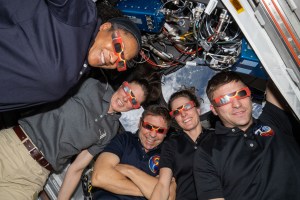
Matt Wilkinson: So the ISS is orbiting around the Earth and it’s constantly moving. So its ability to line up with the eclipse is very difficult. So a lot of times they’re not even in the path of totality when it’s happening. Additionally, we don’t have a lot of windows facing directly up towards the Sun. There are some windows on some of their Dragon and Soyuz vehicles that they can see. But they do have to be careful because they’re out in space without some of the protection that the atmosphere can provide. So we make sure that they don’t look directly at the Sun and just use it through indirect means and photographs that we provide to them.
Host: And so what about future NASA Artemis crewed missions to the Moon? And do you have to plan to avoid eclipses?
Matt Wilkinson: We do, actually. So when we have our astronauts land on the surface of the Moon, we have a couple constraints we need to ensure. One is that they have comm with the Earth. And so that means that where they land needs to be looking towards the Earth. Additionally, we would need them to be in a lit area because they need light so that they can get to the surface, walk around, avoid craters and rocks. So in order for there to be both light where they’re landing and it to be facing the Earth, we can’t have the Sun behind the Moon. So we have to watch out for solar eclipse times to make sure that we have a lit landing area and a landing area facing the Earth. So it is something that we watch out for when we’re planning our missions.
Host: These are things you just do not think about that go into the mission planning, right? And again, that’s just one of the things I love about working here and meeting different people. All different walks of life and then different things you just have to think about on the day-to-day, right? So a short history lesson here to round out the conversation. Eclipses have been part of human history as far back as we can record, or we’ve recorded. Can you tell us anything about the history of solar eclipses?
Matt Wilkinson: Sure. So there’s some really interesting solar eclipses that have occurred throughout history that have been recorded. So in ancient Chinese empires, the eclipses were seen as a dragon eating the Sun. It was an important part of the court astronomers to predict when these would happen because it was seen as a major negative event. Two astronomers failed to predict it around the time of a battle and so they were actually beheaded for their failure. They were punished very harshly for not predicting that eclipse. Later on, Herodotus records that the Lydians and Medes actually stopped fighting because an eclipse occurred during the middle of the battle. And they took that to mean that the gods were angry with them for fighting. We’re also able to pinpoint exactly when a civil rebellion occurred in the city of Ashur because it corresponded to an eclipse that we know about. So there’ve been really interesting periods. We’ve been able to, you know, pinpoint exactly when things happen because they line up with these eclipses that we can predict very well.
Host: So from dragons to scientific discoveries now, what are some of the discoveries that have come out of these eclipses?
Matt Wilkinson: Sure. So one of the really, really important ones of the 20th century is proving Einstein’s theory of relativity. So he predicted that gravitational bodies, like the Sun, would cause light from other stars to bend, or it’s called gravitational lensing. So in the early 1900s, during an eclipse, they were able to go, several scientists, and observed light from stars behind the Sun that we normally cannot see because the Sun is blocking it. Curve from where they should have been observed on the ground because the Moon was blocking the light of the Sun and that proved that gravitational lensing occurred and therefore proved Einstein’s theory of relativity was correct.
Host: So what types of NASA research is involved in this event? So you might see things like chasing the eclipse with high-altitude planes.
Matt Wilkinson: So one of the things that we still don’t understand super well is the effect of altitude on the atmosphere and how solar radiation pressure can change that. It’s a huge area of research both in aeronautics and in rocketry. So we have our WB-57 planes that are going to be chasing the eclipse and observing how the effect of the blockage of the Sun affects changes in the atmospheric pressure. We also have some sounding rockets that’ll be launched and some balloons that’ll be launched and they’ll have tons of sensors and measuring equipment on board that they will use to measure how the atmosphere changes over a certain area before the eclipse and then during the eclipse and then during the eclipse at different points. So we can crosscheck, you know, how does the eclipse change over different areas and how does the same area change before and after an eclipse? And really get some good insight into how the Sun affects our atmosphere.
Host: To be a passenger on one of those planes would be awesome. Now, how can general citizens contribute to NASA’s research? So there’s different ways, I think I read on the website, you know, seeing what critters are doing or animals, how they might react or if you see anything change in that realm.
Matt Wilkinson: Sure. Yeah. So animals just like we do, you know, react to the Sun. So it’s very interesting to see how, you know, daytime and nocturnal animals will react to that. So there’s a lot of research here. People can also get involved in some of those balloon experiments and if folks want to learn more, they can go to science.nasa.gov/eclipses. Not only can they find out a lot about the research that’s being done, both through NASA and with public involvement, but we also have some really, really cool maps of the path of totality for those who want to maybe plan a trip for this eclipse.
Host: Well we hope this podcast has helped you not only prepare for this exciting event, but you can help share in the excitement, right, of this eclipse that millions are going to be able to see. Be sure to tune in from 12-3 p.m. CDT on April 8 for NASA’s eclipse broadcast that’ll be streaming on all of NASA’s platforms. Matt, thank you so much for joining us. Did you have any last words on the eclipse?
Matt Wilkinson: No, thanks for being here. Just one last time. People, be careful with your eyes. Make sure you’re using proper protection and know where you are and get your eclipse glasses ready.
Host: Thanks, Matt.
[Music]
Host: Thanks for sticking around. I hope you learned something today. Check out nasa.gov for the latest, nasa.gov/podcasts, and for more information on this year’s eclipse, head to go nasa.gov/eclipse2024 as well as NASA Sun on X and NASA Sun Science on Facebook.
On social media, we’re at NASA Johnson on Facebook, X, and Instagram. Use #AskNASA on your favorite platform to submit your idea and make sure to mention it’s for Houston We Have a Podcast. This episode was recorded on March 1, 2024. Thanks to Will Flato, Dane Turner, Abby Graf, Sarah Frazier, Jaden Jennings, Dominique Crespo, and of course, Gary Jordan. And of course, thank you to Matt Wilkinson for taking time to come on the show. Give us a rating and feedback on whatever platform you’re listening to us on and tell us what you think of our podcast. We’ll be back next week.


























